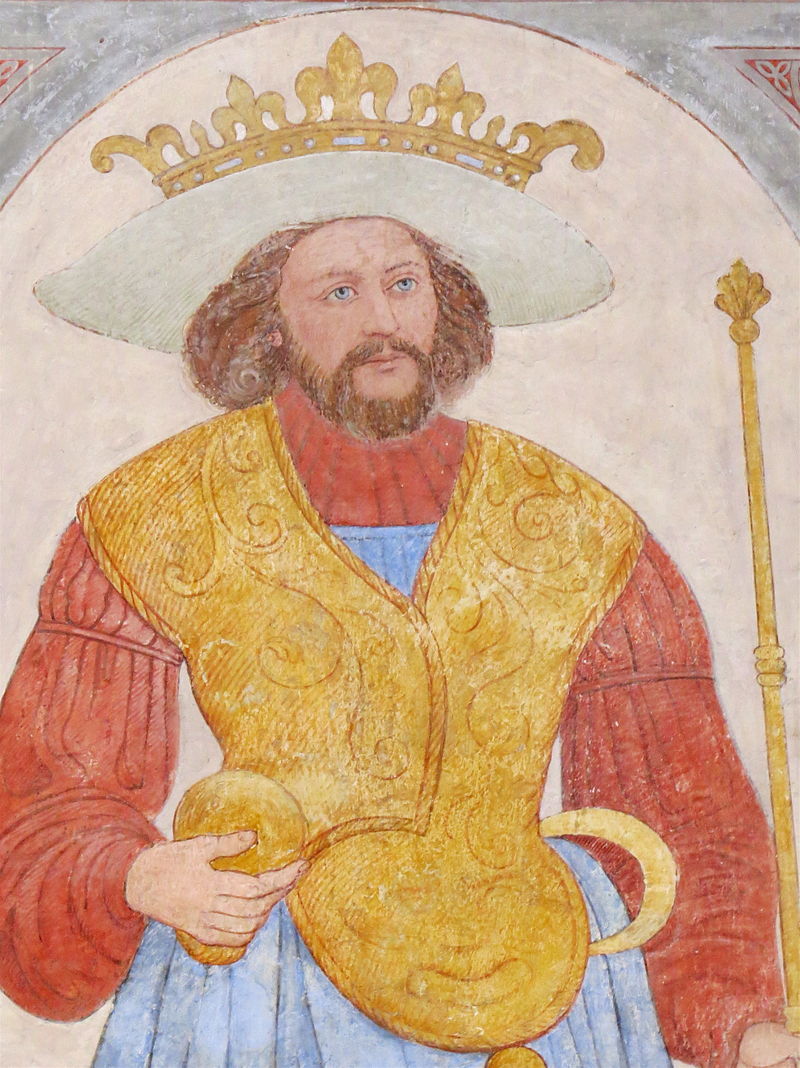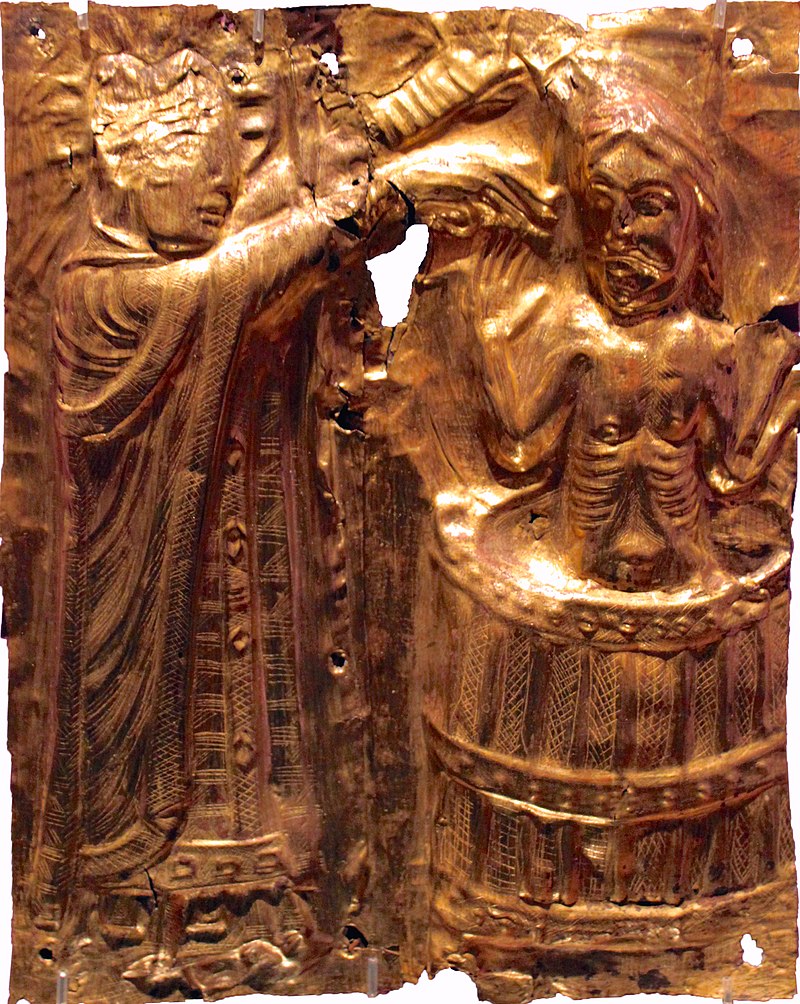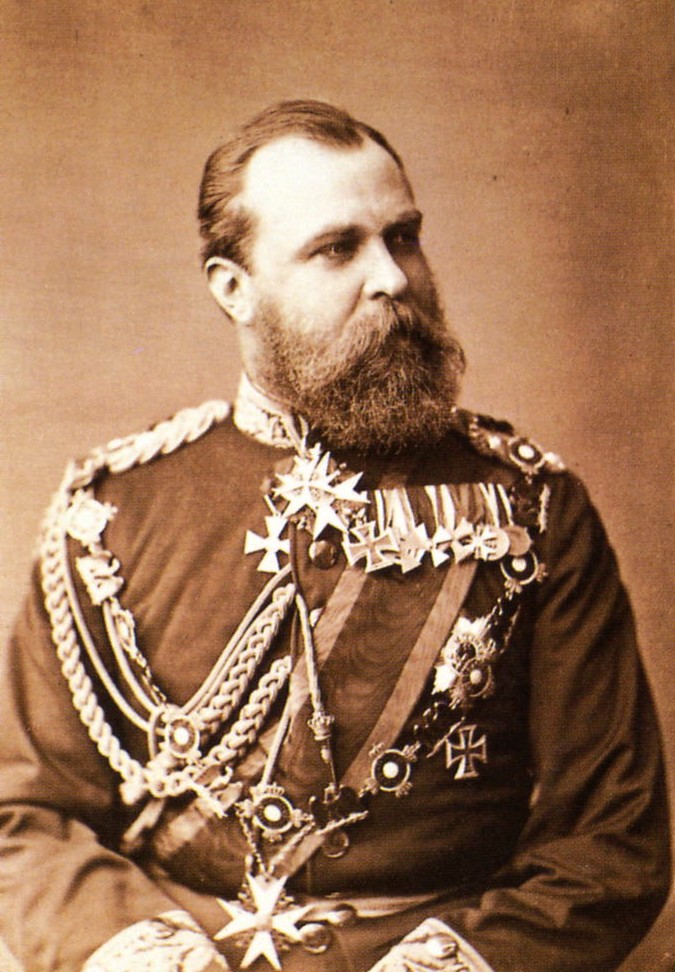by Susan Flantzer
© Unofficial Royalty 2025

Harald Bluetooth – 16th-century fresco at Roskilde Cathedral, Harald’s burial place; Credit – Wikipedia
A Viking warrior, Harald I Bluetooth, King of Denmark, reigned circa 958 – 986, and King of Norway reigned circa 970 – 986, unified Denmark and Norway in the tenth century. His nickname Bluetooth first appears in the Roskilde Chronicle in 1140. Blár means “blue” in Old Norse but it also means “dark”. Possibly Harald had a conspicuous bad tooth that was dark.
Harald Bluetooth was the inspiration for the name of the wireless technology company Bluetooth. The name was based on an analogy that the technology would unite devices the way Harald Bluetooth united the tribes of Denmark into a single kingdom. The Bluetooth logo ![]() is a bind rune merging the runes
is a bind rune merging the runes ![]() (Hagall) (ᚼ) and
(Hagall) (ᚼ) and  (Bjarkan) (ᛒ), Harald’s initials.
(Bjarkan) (ᛒ), Harald’s initials.
Harald Bluetooth was born in Denmark, before 936, probably about 932. He was the son of Gorm the Old, King of Denmark and Thyra Dannebod. Gorm the Old is the earliest reliably verified Danish ruler. His father was supposedly Harthacnut who reigned in the early 10th century. A Norse saga says that Harthacnut was the son of legendary Danish king Sigurd Snake-in-the-Eye, one of the sons of legendary Danish king Ragnar Lodbrok. The existence of Harald’s mother Thyra Dannebod is documented in Viking Age runestone inscriptions, but very little is known about her. Medieval historians and 12th and 13th-century Icelandic sagas disagree with her origin, describing her as the daughter of an English king, the daughter of an Earl of Jutland, or from the area of present-day Germany.
Harald had three siblings:
- Knud Danaast (circa 920 – 962), killed during a military campaign in Dublin, Ireland
- Gunnhild (circa 910 – circa 980), married Eric Bloodaxe, King of Norway, King of Northumbria, had seven children, including Harald II Greycloak, King of Norway
- Toke Gormsson (? – 986), killed in the Battle of Fýrisvellir
Harald’s first wife was Gunhild of Wenden, probably the mother of Sweyn Forkbeard, King of Denmark, Norway, and England. Besides Gunhild, Harald Bluetooth had two other wives, Tove of the Obotrites and Gyrid Olafsdottir of Sweden. Harald had three other children besides Sweyn but it is not certain which of his wives were their mothers.
Harald’s children:
- Sweyn Forkbeard, King of Denmark, Norway, and England (circa 960 – 1014), married to Sigrid Storråda and Gunhilda of Wenden, had seven known children but it is uncertain which of the two women are their mothers
- Tyra Haraldsdatter, married (1) Styrbjörn Starke, Crown Prince of Sweden (2) King Olav I of Norway
- Haakon (born around 961)
- Gunhilde, (died 1002), married Pallig, Jarl and Ealdorman of Devonshire, both were killed in the St. Brice’s Day Massacre in November 1002
Harald succeeded his father Gorm as King of Denmark. It is speculated that Gorm died in the winter of 958 – 959, based on dendrochronology, the scientific method of dating tree rings, showing that his tomb in a burial mound in Jelling, Denmark was made from wood felled in 958. Gorm was around sixty years old when he died, and because of his father’s old age, Harald had already played an important role in governing Denmark.
During Harald Bluetooth’s reign, Denmark was peaceful and Harald focused on foreign affairs. Richard I, Count of Normandy, the great-grandfather of William III, Duke of Normandy, better known as William the Conqueror, King William I of England, allied himself with Harald who then supported Richard I, a descendant of Vikings, against his opponents. Originally Normandy was a French fiefdom created as the County of Rouen in 911 by King Charles III “the Simple” of France for Rollo, a Viking leader whose original name may have been Hrólfr. After participating in many Viking raids along the Seine, culminating in the Siege of Paris in 886, Rollo was finally defeated by King Charles III. Rollo swore fealty to the French King and converted to Christianity. Charles then granted Rollo territories around Rouen, which came to be called Normandy after the Northmen/Norsemen, another name for Vikings. Rollo is the great-great-great-grandfather of William the Conqueror.
In 961, when King Haakon I of Norway was defeated and killed in battle, Harald Bluetooth went to Norway and proclaimed himself King of Norway and appointed the Norwegian regional kings as his vassals. Harald II Greycloak of Norway, the leader of the Norwegian vassal kings and also Harald Bluetooth’s nephew (the son of his sister Gunnhild), killed his most important opponents and became increasingly independent of his uncle Harald Bluetooth. In 970, Harald Greycloak was tricked into visiting Denmark and was killed by allies of his uncle Harald Bluetooth. Harald Bluetooth regained a strong position as King of Norway and appointed Harald Greycloak’s murderers as Jarls in Norway.

Poppo baptizing Harald Bluetooth; Credit – Wikipedia
Harald Bluetooth converted to Christianity. Allegedly, around 965, Poppo, a German priest who was Bishop of Schleswig in the 10th and early 11th centuries, convinced Harald that Jesus Christ was a far stronger deity than the Norse gods. Poppo baptized Harald who then decided that the Danish people should convert to Christianity.
The Great Jelling Stone showing Jesus Christ with outstretched arms but without a cross. Erected by Harald Bluetooth in the latter half of the 10th century; Credit – Af Casiopeia – fotografiert von Casiopeia, CC BY-SA 2.0 de, https://commons.wikimedia.org/w/index.php?curid=197286
Harald’s father Gorm was first buried in the North Mound in Jelling, Denmark. After his conversion to Christianity, Harald had his father’s body reburied in the wooden church he built next to the North Mound in Jelling. Harald erected the Jelling stones including the Great Jelling Stone for his father and mother with the inscription: “King Harald bade these memorials to be made after Gorm, his father, and Thyra, his mother. The Harald who won the whole of Denmark and Norway and turned the Danes to Christianity.”

The modern memorial to Harald Bluetooth in Wolin, Poland. The Danish and Polish inscription, in rune style, commemorates Harald’s death in Jómsborg; Credit – By Radosław Drożdżewski (Zwiadowca21) – Own work, CC BY 3.0, https://commons.wikimedia.org/w/index.php?curid=4318187
In 986, Sweyn Forkbeard rebelled against his father and seized the throne. Wounded after a battle with his son, Harald Bluetooth was driven into exile and died in November 986 in Jomsborg, a Viking stronghold built by Harald Bluetooth on the southern coast of the Baltic Sea. Jomsborg is thought to be the present-day town of Wolin in Poland.

Roskilde Cathedral on the site of Holy Trinity Church built by Harald Bluetooth; Photo Credit © Susan Flantzer
Harald Bluetooth named Roskilde the capital of Denmark in 960. He had a small wooden church dedicated to the Holy Trinity built on the site of the current Roskilde Cathedral, the traditional burial site of the Danish monarchs. Harald Bluetooth was buried at the Holy Trinity Church. His son Sweyn Forkbeard was first buried in England and his remains were later moved to Denmark where they were interred near his father at the Holy Trinity Church. However, their tombs have never been found.
This article is the intellectual property of Unofficial Royalty and is NOT TO BE COPIED, EDITED, OR POSTED IN ANY FORM ON ANOTHER WEBSITE under any circumstances. It is permissible to use a link that directs to Unofficial Royalty.
Works Cited
- Bidragsydere til Wikimedia-projekter. (2003). Harald Blåtand. Wikipedia.org; Wikimedia Foundation, Inc. https://da.wikipedia.org/wiki/Harald_Bl%C3%A5tand
- Bidragsydere til Wikimedia-projekter. (2021). Poppo. Wikipedia.org; Wikimedia Foundation, Inc. https://da.wikipedia.org/wiki/Poppo
- Flantzer, Susan. (2025). Gorm the Old, King of Denmark. Unofficial Royalty. https://www.unofficialroyalty.com/gorm-the-old-king-of-denmark-reigned-936-958/
- Flantzer, Susan. (2021). Roskilde Cathedral in Roskilde, Denmark. Unofficial Royalty. https://www.unofficialroyalty.com/roskilde-cathedral-in-roskilde-denmark/
- Flantzer, Susan. (2019). Sweyn Forkbeard, King of Denmark, Norway, and England. Unofficial Royalty. https://www.unofficialroyalty.com/sweyn-forkbeard-king-of-denmark-king-of-norway-king-of-england/
- Harald Bluetooth. (2021). Wikipedia. https://en.wikipedia.org/wiki/Harald_Bluetooth








